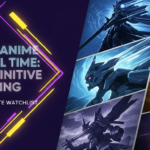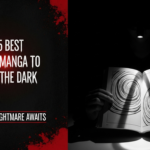Delving into the psyche of One Piece‘s Kaido is like navigating a tempestuous sea. Here stands a being hailed as the “Strongest Creature,” a Yonko whose very presence shakes the world, yet his most infamous hobby? Attempting suicide. This bewildering contradiction sparks endless questions among fans: why does someone seemingly invincible crave death? Many One Piece enthusiasts grapple with understanding Kaido’s complex motivations, often finding the reasons scattered across numerous chapters and fan theories. It can feel overwhelming to piece together the philosophy, boredom, and historical echoes driving this formidable character’s death wish.
Kaido’s desire to kill himself stems from a complex mix of his belief that death grants ultimate glory, profound existential boredom born from near-invincibility, and a longing to achieve a legacy comparable to legendary figures like Oden, Roger, and Whitebeard.
This deep dive aims to provide the full explanation, drawing directly from One Piece canon and authoritative analyses. We’ll unravel Kaido’s core beliefs about life and death, explore the crushing weight of his unmatched power, and examine how figures from the past shaped his pursuit of a “great death.” Prepare to understand the intricate layers behind one of anime’s most fascinating antagonists and why simply ending his life was never Kaido’s true goal.
Key Facts:
* Philosophy on Perfection: Kaido explicitly stated in Chapter 944, “But rather in death, that humans truly attain perfection,” highlighting his core belief linking death to ultimate achievement. (Source: opfanpage.com)
* Idolization of Legendary Deaths: He deeply admires the epic deaths of figures like Kozuki Oden, Whitebeard, and Gol D. Roger, desiring a similarly glorious end for himself. (Source: opfanpage.com)
* “Suicide” as a Hobby: His immense strength and inability to be easily killed led him to treat attempting suicide—like jumping from the sky island Balloon Terminal—as a morbid pastime born from boredom. (Source: Fanverse Forum Discussion)
* Seeking Meaning: Kaido’s pursuit isn’t just about ending his life, but finding meaning and achieving historical significance through a spectacular death, unlike mundane options. (Source: opfanpage.com, Quora discussions)
* Invincibility’s Burden: Being nearly unkillable contributes significantly to his apathy and dissatisfaction, making challenges meaningless and fueling his desire for a definitive, impactful end. (Source: One Piece Wiki – Personality Section)
Who is Kaido and Why is His Death Wish a Mystery?
Kaido, known as the “Strongest Creature” and one of the Four Emperors in One Piece, paradoxically seeks death as a “hobby,” attempting suicide numerous times despite his near-invincibility, creating a major character mystery. He commands the fearsome Beast Pirates and rules over Wano Country with an iron fist. As one of the Yonko, the four most powerful pirates ruling the latter half of the Grand Line (the New World), Kaido possesses monstrous strength, rumored invincibility, and the ability to transform into a colossal azure dragon thanks to his Mythical Zoan-type Devil Fruit, the Uo Uo no Mi, Model: Seiryu. Yet, despite this overwhelming power and status, Kaido is tragically defined by an unusual, persistent desire: he wants to die. This jarring juxtaposition between his god-like power and his suicidal tendencies forms one of the most intriguing character enigmas in the vast world of One Piece. Why would someone who seemingly has everything, including the inability to be easily killed, actively seek his own demise?
Kaido’s Introduction: The Unkillable Man
Our first proper introduction to Kaido is nothing short of spectacular and utterly perplexing. In Chapter 795, titled “Suicide,” readers witness Kaido plummeting 10,000 meters from the sky island, Balloon Terminal. His goal? To kill himself. He lands with catastrophic force, creating a massive crater, only to emerge completely unscathed, complaining merely of a headache.

This dramatic entrance immediately establishes his nigh-invulnerability and his bizarre hobby. The narration highlights his history: captured 18 times, sentenced to death 40 times, sinking nine massive prison ships. Every attempt to execute him—by hanging, guillotine, or impalement—failed, breaking the instruments themselves. This history hammers home the core conflict: a man who cannot be killed by others, trying (and failing) to kill himself.
Reputation as the “Strongest Creature”
Kaido’s reputation precedes him throughout the One Piece world. He is universally referred to as the “Strongest Creature” (地上最強の生物, Chijō Saikyō no Seibutsu). This title isn’t just hyperbole; it reflects his unparalleled physical prowess, durability, and combat ability. People often say, “If it’s one-on-one, Kaido will win.” This speaks volumes about his terrifying strength and the belief that no single individual could possibly defeat him in a fair fight. His Mythical Zoan fruit grants him incredible powers—flight, weather manipulation (like creating lightning and tornadoes), and devastating heat beams (Bolo Breath)—in addition to his already immense physical strength, Haki mastery, and resilience. This overwhelming power, however, becomes a double-edged sword, feeding into the very reasons he courts death.
Why Does Kaido Want to Kill Himself? Unpacking the Reasons
Kaido wants to kill himself due to his belief that death grants true glory and perfection, profound boredom stemming from his invincibility, and a deep dissatisfaction with his own legacy compared to figures like Roger and Whitebeard. His motivations are multifaceted, rooted deeply in his personal philosophy, his experiences, and his perception of the world. It’s not a simple death wish but a complex yearning for meaning, impact, and an end worthy of his immense power—an end he feels perpetually denied. Understanding why Kaido seeks death requires looking beyond the surface act and into the core of his character.
Kaido’s Philosophy: Death as the Ultimate Glory
Kaido believes death is what truly completes a person, granting ultimate glory. He idolizes figures like Whitebeard and Oden, seeking a similarly legendary and impactful end to cement his own legacy. At the heart of Kaido’s suicidal ideation lies a distinct philosophy regarding death and achievement. He doesn’t see death merely as an end but as the ultimate culmination of a life, the event that solidifies one’s place in history. In Chapter 944, he muses, “But rather in death, that humans truly attain perfection.” This statement provides critical insight into his worldview.
He looks towards the legendary figures of the past generation—Gol D. Roger, the Pirate King; Edward Newgate, known as Whitebeard; and Kozuki Oden, the valiant samurai of Wano—and sees their deaths as monumental events. Whitebeard’s defiant stand and final words at the Battle of Marineford, Roger’s execution that sparked the Great Pirate Era, and Oden’s incredibly honorable death by boiling while holding his retainers aloft—these are the standards Kaido measures against. He explicitly admired Whitebeard’s end, calling it “the right way to die.” Kaido feels his own life, despite his power, lacks the same significance, and he believes only a similarly “great death” can grant him the recognition and perfection he craves. He is jealous, deep down, of the meaning those deaths held, even if he misinterprets why they were meaningful (focusing on the spectacle rather than the inherited will).

Existential Boredom and the Burden of Invincibility
As arguably the ‘Strongest Creature,’ Kaido suffers from extreme boredom due to a lack of meaningful challenges. His invincibility breeds apathy, leading him to treat suicide attempts as a morbid hobby to feel something. Being virtually indestructible comes at a cost: life loses its thrill. Kaido’s immense strength ensures that few can challenge him, and even fewer can pose a genuine threat. This lack of meaningful conflict leads to profound, chronic boredom and a pervasive sense of apathy. The world feels mundane, predictable, and devoid of excitement for someone who cannot easily be harmed or defeated.
This state of ennui is a significant driver behind his suicidal “hobby.” The attempts themselves—jumping from extreme heights, facing execution—are perhaps less about actually dying (as he likely knows they won’t succeed) and more about seeking any kind of intense sensation, a thrill, or a flicker of the danger that life no longer offers him. He even seems to relish tough fights, perhaps because they offer a brief respite from the monotony of invincibility. His desire to ignite the “greatest war the world has ever seen” can also be interpreted through this lens—an attempt to shatter the mundane and create chaos grand enough to finally feel alive, or perhaps, die a meaningful death within it.
Connection to Joy Boy and Perceived Failure
Kaido’s fascination with the legend of Joy Boy, coupled with his realization he might not embody it, potentially fuels his desire for a meaningful end, possibly through defeat by the prophesied figure. Another layer adding complexity to Kaido’s motivations involves the legendary figure Joy Boy. In the world of One Piece, Joy Boy is a significant historical figure prophesied to return and bring about a great change, often associated with liberation and bringing smiles. Kaido shows a keen interest in this legend, even pondering if he could be Joy Boy.
However, his brutal, tyrannical methods and conquest-driven ambitions clash starkly with the ideals Joy Boy represents. It’s suggested that Kaido eventually realized he could not be Joy Boy, possibly leading to a deeper sense of failure and inadequacy. If he couldn’t be the figure of liberation and grand change, perhaps the only meaningful role left was that of the ultimate obstacle, destined to be overcome by the true Joy Boy. During his climatic battle with Luffy in Wano, Kaido directly questions if Luffy is Joy Boy, acknowledging that only such a figure could potentially defeat—and thus, kill—him. This suggests his death wish might be intertwined with a desire to be defeated by someone worthy, someone representing the very legend he failed to embody, providing his existence and inevitable end a form of significance after all.
Why Doesn’t Kaido Just Drown Himself? Addressing the Obvious
Although Kaido is a Devil Fruit user vulnerable to drowning, he avoids this simple death because it lacks glory. He seeks a legendary, memorable end, not an ordinary or insignificant one like drowning. This question frequently arises among fans. Given that Kaido possesses the power of the Uo Uo no Mi, Model: Seiryu, a Mythical Zoan Devil Fruit, he shares the universal weakness of all Devil Fruit users: vulnerability to the sea. Submersion in still water weakens users, while the sea itself paralyzes them, making drowning a seemingly straightforward method for suicide. So, why hasn’t the “Strongest Creature” simply plunged into the ocean depths? The answer lies squarely within his core philosophy.
The Devil Fruit User’s Weakness
It’s a fundamental rule in the One Piece universe: Devil Fruit users gain incredible powers at the cost of being hated by the sea. They become “hammers” in water, unable to swim and losing their strength upon significant submersion. This weakness is absolute and affects even the most powerful individuals, including Yonko like Kaido and Big Mom. Therefore, technically, jumping into the sea and allowing himself to sink would be a guaranteed way for Kaido to die. The simplicity and availability of this method make his elaborate and often flamboyant suicide attempts (like the sky-island jump) seem even more perplexing if the sole goal were just oblivion.
The Importance of a “Great Death”
For Kaido, the way one dies is paramount. He craves a ‘great death’—one that shakes the world and ensures his legacy—making a simple drowning entirely undesirable for him. The reason Kaido shuns drowning is precisely because it’s too simple, too mundane, too inglorious. His entire obsession revolves around achieving a death that echoes through history, a spectacular end worthy of his immense power and fearsome reputation. He wants his death to be a statement, much like the deaths of Roger, Whitebeard, and Oden were.
Drowning silently beneath the waves offers none of that. It’s a quiet, unremarkable end, devoid of the chaos, conflict, and historical impact he associates with true greatness. It wouldn’t “complete” him in the way he believes a legendary death would. Therefore, he actively seeks out situations involving immense danger, powerful opponents, or large-scale conflict—arenas where a “great death” might potentially be found—rather than opting for the easy but ultimately unsatisfying escape offered by the sea. His pride and philosophy demand grandeur even, perhaps especially, in demise.
Watch: This clip highlights Kaido’s introduction and first suicide attempt:
What Were Kaido’s Known Suicide Attempts?
Kaido’s documented suicide attempts include jumping 10,000 meters from the sky island Balloon Terminal (Chapter 795) and enduring countless failed execution attempts by Marines and other Yonko, showcasing his extreme durability. While Kaido claims suicide as a hobby, the One Piece narrative highlights specific instances that underscore both his desire for death and his incredible inability to achieve it through conventional (or even unconventional) means. These attempts serve to establish his immense resilience and frame the tragic irony of his existence.
The most iconic attempt is his previously mentioned jump from Balloon Terminal, a sky island situated 10,000 meters above the sea. This wasn’t a random fall; it was a deliberate dive aimed at self-destruction, as detailed in Chapter 795. The sheer impact should have obliterated any normal being, yet Kaido walked away with minor irritation.
Beyond his self-inflicted attempts, Kaido has a notorious history of surviving capture and execution. The series explicitly states he has been:
* Defeated 7 times as a pirate.
* Captured by the Marines and rival Yonko 18 times.
* Sentenced to death 40 times.
During these executions, various methods were employed:
* Hanging: The ropes snapped.
* Guillotine: The blades shattered.
* Spears/Impalement: The spears broke upon impact.
His body proved too durable for any execution method conceived. This history isn’t presented as Kaido allowing himself to be captured merely to test execution methods, but rather as a testament to his overwhelming power and resilience throughout his pirating career. He simply could not be killed, even when defeated and captured by powerful enemies. These collective experiences—both the self-initiated attempts and the failed executions by others—solidify his status as the “unkillable” man and fuel the existential dread driving his quest for a worthy end.
FAQs About why does kaido want to kill himself:
Why does Kaido want to die if he’s so strong?
Kaido wants to die precisely because his overwhelming strength leads to profound boredom and a lack of meaningful challenges. He feels life is mundane and seeks a “glorious death” like legendary figures, believing it’s the only way to achieve true perfection and leave a lasting legacy.
Did Kaido actually want to die or just test his limits?
It’s a combination; while he genuinely seeks a meaningful, glorious death, his attempts also serve as a grim “hobby” born from boredom and perhaps a way to feel something or test the boundaries of his invincibility. He doesn’t seek just any death, but one with significance.
Why didn’t Kaido eat a second Devil Fruit to die?
Eating a second Devil Fruit causes a user’s body to supposedly explode, but this method, like drowning, would likely be considered an inglorious or unremarkable death by Kaido. He seeks a death tied to legend, battle, or world-shaking events, not a relatively simple (though destructive) self-implosion.
What specific events made Kaido suicidal?
No single event is pinpointed, but his condition seems to stem from a lifetime of unmatched power, the resulting chronic boredom, his interpretation of legendary deaths (Roger, Whitebeard, Oden), and potentially a disillusionment related to the Joy Boy legend.
How does Kaido view death compared to other One Piece characters?
Kaido uniquely romanticizes death as the ultimate achievement and path to perfection, contrasting sharply with characters like Luffy who value life, freedom, and dreams, or others who fear death or see it simply as an end.
Was Kaido’s desire for death linked to his Devil Fruit?
Indirectly. His Devil Fruit grants him immense power and durability, contributing to his invincibility, which in turn fuels his boredom and desire for a challenging, meaningful death that his power makes difficult to attain. The fruit itself doesn’t directly cause the desire.
Did Kaido want Luffy to kill him?
During their final battle, Kaido seemed to acknowledge Luffy (especially if Luffy was Joy Boy) as a potentially worthy opponent capable of giving him the significant defeat/death he craved. He wasn’t explicitly asking for death, but recognized Luffy might be the one to finally achieve it.
Why was Kaido obsessed with Oden’s death?
Kaido deeply respected Oden’s incredible willpower and the extremely honorable, legendary way he died (boiling alive while saving his retainers). Oden’s death represented the kind of glorious, impactful end that Kaido himself desired but felt unable to achieve.
Is Kaido’s suicide wish a common trope in manga/anime?
While characters grappling with immortality or overwhelming power exist, Kaido’s specific portrayal—treating suicide as a hobby driven by boredom and a desire for a specific kind of glorious death—is a relatively unique and complex take on the theme.
What does Kaido mean when he says death “completes” a person?
He means that a person’s true measure and legacy are finalized and cemented by the manner of their death. A legendary death equals a legendary existence, achieving a form of historical perfection in his view.
Did Kaido ever succeed in finding a ‘glorious death’?
While Kaido was ultimately defeated by Luffy in a monumental battle that shook Wano, whether he considered this the “glorious death” he sought is debatable. His fate post-defeat (falling into magma) wasn’t explicitly shown as the kind of recognized, celebrated end he idealized.
How did Kaido’s crew react to his suicide attempts?
His crew, the Beast Pirates, mostly seemed unfazed or accustomed to his bizarre behavior, likely due to his overwhelming power and volatile nature. They feared him immensely and rarely questioned his actions, understanding his near-invincibility.
Summary:
Kaido’s persistent desire to kill himself is far more intricate than a simple wish for oblivion. It’s a tangled knot of philosophical beliefs, existential ennui, and a deep-seated yearning for a legacy etched in history through a “great death.” Driven by the idea that death grants perfection and glory, inspired (and perhaps misinterpreted) by the legendary ends of figures like Roger, Whitebeard, and Oden, Kaido finds himself trapped by his own immense power. His invincibility breeds a crushing boredom, rendering life devoid of thrill and pushing him towards seeking extreme sensations, even through failed suicide attempts. His complex relationship with the Joy Boy legend adds another layer, suggesting a potential sense of failure fueling his desire for a meaningful conclusion, possibly through defeat by a worthy adversary. Ultimately, Kaido doesn’t want just death; he craves a legendary, historically significant end that his unique circumstances make paradoxically elusive.
What are your thoughts on Kaido’s motivations? Do you think his defeat provided the closure he sought? Share your insights in the comments below!



